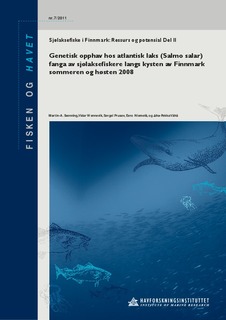| dc.description.abstract | A multistock Atlantic salmon (Salmo salar) sea-fishery operates off the coast of Finnmark, the
northernmost county in Norway, where the average annual landings the last 15-20 years have been
200-300 tonnes. This is approximately equal to the total annual river landings in the 43 Finnmark
rivers. The total river and sea-fishery catch in Finnmark constitutes around 50 % of the total catch
of Atlantic salmon in Norway. The salmon sea-fishery in Finnmark has long cultural traditions, and
has been under strong debate the last 10 years, due to the complexities involved in the potential
mixed stocks harvesting, especially since Russian salmon from more than 60 Kola rivers may also
7
be harvested during their homeward spawning migration.
To increase our knowledge of adult Atlantic salmon along the Finnmark coastal area, the Kolarcticproject
”Sea salmon fishery – resources and potential” was initiated in summer 2008. The project
was a co-operation between Norwegian Institute for Nature Research (NINA-Tromsø), Finnish
Game and Fisheries Research Institute (RKTL), The County Governor of Finnmark and the three
sea-fishery organizations in Finnmark. From 2009, the Institute of Marine Research (IMR-Bergen)
and the Polar Research Institute of Marine Fisheries and Oceanography (PINRO-Murmansk) were
included and from 2010 also the University of Turku.
Between mid May and late July 2008, more than 4 200 salmon were captured (hook net and
keyway) by local sea-fishermen along the Finnmark coast. All fish were measured and weighed,
their sex and maturity defined, the number of sea lice counted, and their stomachs frozen. Scales
were sampled from all fish, and 3 000 individuals were analyzed for microsatellite genetic markers,
in an attempt to define country, region and/or specific river origin of each salmon.
To determine the origin of the salmon caught in the sea fisheries, the genetic data of individuals
were compared to a database of genetic profiles from 51 rivers in north Norway and Russia, using
statistical assignment methods. These methods assigned each fish with a given probability to
possible source populations. The precision of the assignment depends both on the coverage of the
genetic baseline and the number and variability of the genetic markers used. In this study, we
compared the performance of two different baselines; one consisting of 18 microsatellite markers
covering all rivers, but with a limited coverage of the River Tana, the largest river within the survey
area, and one consisting of 12 microsatellite markers with a more complete coverage of the Tana
River system. The results showed that while the precision in general (measured as correct
assignment to home river) achieved was higher using the 18 marker baseline, the limited coverage
of the Tana system led to mis-assignment of fish belonging to this river system to other rivers in the
region. There was, however, a general tendency for mis-assigned fish to be assigned to rivers
within the same region, consistent with an isolation by distance pattern, where geographically close
populations are more similar than distant ones.
In Western Finnmark, the proportion of 1- and 2-seawinter Russian salmon in the catches decreased
from 60 % in May to ca 10 % in July (given a precision level of p>0.7), suggesting that Russian
salmon approached the Finnmark coast from the west in summer 2008. The proportion of 3-
seawinter Russian salmon was, however, very low (< 3 %) during the entire fishing season (May-
July). The proportion of Tana salmon in western Finnmark decreased from 18 % in May to 12 % in
July, whereas all Tana salmon captured in western Finnmark in May were 3-seawinter salmon. The
amount of 1-seawinter (small) Finnmark salmon increased during summer, indicating that also
small Finnmark salmon approached the coast from the west, although significantly later than the
larger salmon (2- and 3-SW).
In Eastern-Finnmark (Varanger fjord) the proportion of Russian salmon was fairly high during the
entire fishing season, although deceasing from 67 % in May to 50 % in late July. Also the amount
of large Russian salmon (3- and 4-seawinter) was very high in May (70 %), but decreased
significantly during summer, being less than 15 % in late July. The relatively high incidence of
large Russian salmon in Eastern Finnmark in May may indicate that the larger salmon have a
different migration patterns, and/or use other feeding areas, compared to salmon from the
Norwegian/Finnmark rivers.
The incidence of Russian salmon was low in the catches within the Tana fjord, while the amount of
Tana salmon in the catches was at the same level both from western and eastern Finnmark. This
may indicate that Tana/Finnmark salmon, after feeding in winter in the Barents Sea, may approach
the Finnmark coast both from west, north and east. Some salmon/populations may, however, feed
in the eastern coastal area in winter. The migration patterns of Atlantic salmon along the Finnmark
coast in summer may thus be very complex.
Our results illustrate that by developing a genetic base line for Atlantic salmon populations in
North-Norway and Russia, it is possible to document the genetic origin of salmon caught along the
8
Finnmark coast. By expanding the number of baseline rivers and increasing the number of genetic
markers, we will be able to not only confirm from which home region or country the salmon
originate, but also determine the home river for each salmon caught. In 2013, during the new
Kolarctic-salmon project (2011-2013), an improved baseline will be finalized, giving the
management authorities a new tool to ensure a future viable exploitation of the northernmost
Atlantic salmon populations in Europe. | |
